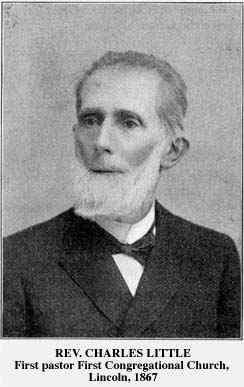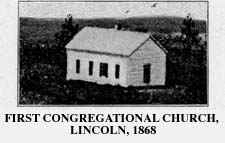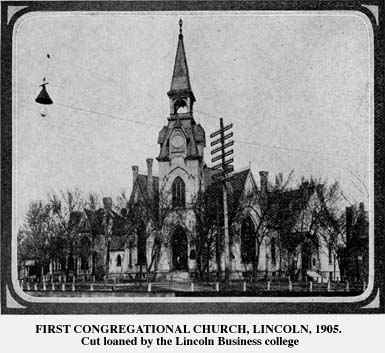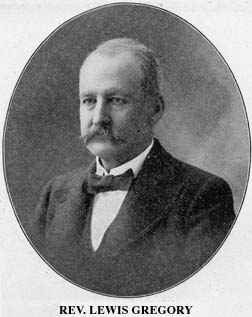
NEGenWeb Project
Resource Center
Church
We have noted in a general way the growth of our churches throughout the state "beginning at Jerusalem,"

in this case Omaha; seeing the little church organized by Father Gaylord growing in strength and numbers, sending
| 118 |
CONGREGATIONAL NEBRASKA
|
colonies here and there in the rapidly growing city until our Congregational Zion numbers in that city eight churches. We have seen Fremont become a strong and leading church under the successive pastorates of able men. We have noted the increase in the number of churches and men, but have felt constrained rapidly to pass by the development of church life in various places.
A chapter devoted to some phases of church life in different parts of the state may be of positive value. Especially is this true since the writer has been able to call to his aid

the help of men who were on the field and entered largely into the work concerning which they write.
It is a source of great gratification to the writer that these busy men have been willing to take the time to give this valuable service to the churches. The first to respond is Rev. Lewis Gregory, who for twenty-three years was pastor of the First Congregational Church in Lincoln, and is now president, of the American Savings bank in that city. Mr. Gregory writes of
CONGREGATIONALISM IN. LINCOLN
"Congregationalism in Nebraska was ten years old and had ten churches when it began regular services in Lancaster county. This was one of the least settled of the eastern
|
PHASES OF CHURCH GROWTH
|
119
|
counties. Only 116 votes were polled in the county at an exciting election in 1866. A county seat, the present site of Lincoln, was laid off in 1864 and named Lancaster.
"Rev. E. C. Taylor preached here occasionally as an outstation of Greenwood. In August, 1866, a little church of

six members was organized. This is the oldest existing church in Lincoln. The minutes of the council state that there were then seven buildings in the town, viz., a schoolhouse, a store, a blacksmith shop, and four dwellings. In the following summer it was decided to locate the state capital here, and call the town Lincoln. In December of
| 120 |
CONGREGATIONAL NEBRASKA
|
the same year (1867) Rev. Charles Little, having been chosen pastor of the Congregational Church, set about securing for it a meeting-house. This was erected in 1868 at a cost of $2,778, and was the first permanent building dedicated to the worship of God in Lincoln.

"For a few years there was an ecclesiastical society connected with the church, after the old New England fashion, but was discontinued in 1873. After an arduous and self-sacrificing pastorate Mr. Little resigned in 1870, leaving a church of thirty-four members, Mr. Little afterward returned to Lincoln, where he and his wife are buried.
"His successors, Rev. L. B. Fifield and Rev. S. R. Dimmock, were men of scholarly ability and oratorical gifts.
|
PHASES OF CHURCH GROWTH
|
121
|
Considerable additions were made to the church, but there was so much going as well as coming that the residue was small. However, the congregation of strangers kept increasing. The church building was enlarged and mortgaged.
"By act of the state legislature of 1869 lots were given to churches erecting buildings within two years. As a consequence there was an unfortunate division of effort and multiplication of church edifices. All the parishes were in debt; religious interest declined. When Mr. Dimmock resigned in 1875 there were only about fifty active members on the roll.
"The church seriously considered whether it was not best to disband. In the good old Congregational way they called a council to advise on the matter. The council discouraged the idea of disbanding, and the church decided to go forward.
"The failure to ask advice, and the mistake of looking only on the surface for the results of the first hard years of pioneering have wrecked many Nebraska churches. They abandon the foundations laid, and leave the good seed sown in tears, when only a little more persistence and patience are necessary to justify the years of labor seemingly spent in vain. Later in the same year (1875) a call was extended to Rev. Lewis Gregory who continued in the pastorate twenty-three years. He was succeeded in 1898 by Rev. W. H. Manss, followed in 1903 by Rev. J. E. Tuttle, D.D., the present minister.
"These thirty years have witnessed a steady growth. The church is now the largest of our order in the state. It shares with its seven sister churches of our order in the city, with their united membership of 1,773, the honor of contributing largely to the religious life of Lincoln and Nebraska.
| 122 |
CONGREGATIONAL NEBRASKA
|
"It is to the credit of our denominational fellowship that none of these churches, Lincoln First, Plymouth, First German, Vine Street, Butler Avenue, Swedish, Zion, and Salem, sprang out of dissension or rivalry. Each, with the approval of all, is located in a distinct parish in centers of influence. Each has been established in turn to meet the growing needs of population and the general interests of Christ's Kingdom.
"The history of the German churches of Lincoln is of special interest. The largest German church of our order is located in Lincoln. More German Congregationalists are here than in any other city of our country. The origin of this work in 1889 came of the helping hand extended by the Congregationalists of the city in suggesting and contributing to a place of worship for the German people coming here, poor but thrifty, to escape the exactions of Russian despotism. In the way of sympathy, advice, and little courtesies, mutual good will has grown until in appreciation of its liberty and fellowship Congregationalism has no more loyal children than our German brethren of Lincoln."
It may be added that Mr. Gregory's characteristic modesty prevented him from saying how large a factor he himself was in building up the First Church, erecting its present attractive church building, establishing the other Congregational churches, and in helping our German brethren to see in our church polity the freedom for which they had hungered when in their German villages in Russia. Whole villages of these Russo-Germans emigrated in a body from Russia to Nebraska. A people intensely religious and devoted, liberty loving, and loyal, they soon found in our fellowship a congenial church home.
We now have German churches in Alliance, Butte, Crete, Deweese, Friend, Germantown, Guide Rock, Hallam, Hastings, Hayes County, Inland, Lincoln, McCook, Napier,